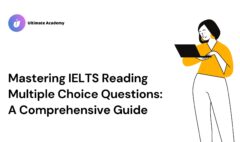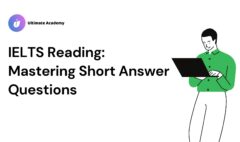Ultimate IELTS Letter Writing Guide
In IELTS General Training Writing Task 1, you will be required to write a Letter for 150 words.
Now all the guides will tell you to focus on things like grammar, vocabulary, task response, coherence, and cohesion.
But what do these terms even mean?
Honestly, you don’t even need to know that to score 8+ Band in IELTS.
What an IELTS Letter really demands is an effective structure and a few simple rules.
In this Ultimate Guide, I am going to share the effective strategies to write an outstanding letter to get 8+ Band in IELTS writing task 1.
Section 1
-
- Overview
Section 2
-
- Types of Letters
Section 3
-
- Reasons for writing letters
Section 4
-
- Greetings and Signing off
Section 5
-
- How to begin and end your letter
Section 6
-
- Paragraph and Structure
Section 7
-
- Planning and Writing
Section 8
-
- Grammar and Punctuation
Section 9
-
- Vocabulary
Section 10
-
- Tips for writing letters
Overview
In IELTS Writing Task 1, you will be asked to write a Letter.
A letter should be between 150-180 words.
The limit of 150 is the minimum and below that your score will get negatively affected.
Writing more than a 180 is fine but I’d prefer you stay within the limit of 150-180 to make the most use of your time as well as decrease the chances of spelling and grammatical errors by writing more.
In Writing Task 1, you are given instructions to write a letter and three bullet points to include in your letter.
You have to cover all three points otherwise you will end up scoring low Band.
Just by answering each of these points in two to four lines, you will hit 150 words in a jiffy.
Types of Letter
There are three types of letter:
- Informal Letter
- Semi-Formal Letter
- Formal Letter
Informal Letter
An informal letter is a personal letter to someone you know personally, about a social situation or a personal situation.
For example, write a letter to one of your friends who recently had a birthday celebration, but you missed it and you forgot to tell your friend why you couldn’t attend.
In your letter:
- Apologize for missing the birthday.
- Explain why you missed it and why you didn’t tell your friend.
- and say what you like to do to show that you are sorry.
Semi-Formal Letter
A semi-formal is to the person such as your office colleague, boss, or, manager but the issue is work-related or some serious matter.
For example, you’ve been doing some volunteer work to help your local community. However, now you’re unable to continue doing this work. Write a letter to the manager of the organization where you have been working.
In your letter:
- Describe the work you have been doing.
- Explain why you can no longer do this work.
- Recommend another person who is interested in the work.
Formal Letter
The formal letter is to the person you don’t know and the issue is serious or formal in nature.
An example is your local hospital has advertised for people to do unpaid work by helping at the hospital. You would like to do some work at the hospital in your free time. Write a letter to the hospital.
In your letter:
- Explain why you would to do unpaid work at the hospital.
- Say what type of unpaid work you would be able to do.
- Give details of when you would be available for this work.
Reasons for Writing Letters
Below are some possible reasons for writing each letter.
Informal Letter
- For apologizing.
- To give information about something.
- To give the explanation of something.
- To give an invitation to any event.
- Or to make any request.
Semi-Formal Letter
- To offer an apology.
- To provide any information.
- To make any request.
- To give an explanation.
- To give the invitation to any event.
Formal Letter
- For apologizing.
- To make any request.
- To ask for any guidance or assistance.
- For complaining about something.
- Applying for the job.
- Resigning from the given position.
- To give an invitation for any event.
- For thanking or expressing your gratitude.
Greetings and Signing off
For Informal Letter
- Always start an informal letter with words like “Dear”. And you must always write the name of the person you are writing the letter to, such as “Dear Emilia”. Never use Mr. and Mrs. in an informal letter; and never use the full name of the person.
- You can use the following phrases for signing off the informal letter: Best regards / Best wishes / I hope to see to soon / Take care / All the best
- Never say “yours sincerely or yours faithfully”. You will get a negative mark for that. Also, don’t use words like “lots of love or kisses”.
- At the end, write your first name only.
For Semi-Formal Letter
- Start your semi-formal letter with “Dear” and then write the name of the person you are writing a letter to. In a semi-formal letter, you should always use salutation (Mr. or Mrs.). E.g. “Dear Mr. Timothy:
- Always sign off the semi-formal letter with
“Yours sincerely”
Your full name
For Formal Letter
- Always start your formal letter with:
“Dear sir or madam”
I am writing this letter with regards to.
- And sign off with:
I am looking forward to hearing from you.
Yours faithfully,
Your full name
How to Begin and End your Letter
Beginning your Letter
Opening and closing statements are very important in letter writing. The opening sentence is usually the reason for writing the letter and varies according to the type of letter.
For Informal Letter
For an informal letter, you can start by asking how your friend is doing, or refer to the time you two had spent together, or you can write about something your friend mentioned in the previous letter. And then mention the reason for writing the letter.
For example:
Dear Timothy,
It’s been so long since we were last in touch but I haven’t forgotten all the wonderful times we spent together last year. It’s my birthday coming up and I wanted to invite you over to stay at my place for the celebration…
Or
Dear Ann,
Thanks for your letter, it was so interesting to read about your new house and the photo you sent is amazing. I just thought I’d write to let you know that I finally quit my job…
For Semi-Formal Letter
For a semi-formal letter, directly mention the reason for writing the letter.
For example:
Dear Mr. Jones,
I am writing you to request a few days of unpaid leave in March…
Or
I am writing to say thank you for the offer of joining your company…
For Formal Letter
For a formal letter, start by giving a short explanation of the reason for writing the letter.
For example:
I am writing this letter with regards to the scholarship program to study at London University which I read in Sunday Times on December 1st, 2014…
Or
I am writing this letter to express my dissatisfaction with….
Ending your Letter
For Informal Letter
You can write following closing sentences for an informal letter:
It will be great to catch up again soon. Give my best to everyone in the family.
I can’t wait to hear all about….
For Semi-Formal Letter
You can write following closing sentences for a semi-formal letter:
I am looking forward to hearing from you.
I would be very grateful if you could allow me to take these four days off as it is very important to my parents that I attend and I’d appreciate it if you could let me know by the end of the week.
For Formal Letter
You can write following closing sentences for a formal letter:
I look forward to hearing from you.
I would be very grateful if you….
I would like to thank you in advance for…….
Thank you for giving your attention to this complaint/matter.
Structure & Writing
Always follow a 5-part structure for your letter whether it is informal, semi-formal, or formal. You have to include every bullet point in your letter otherwise you will get a negative mark.
Structure of each letter will be:
- Reason for writing (1-2 lines)
- Explain the first bullet point (2-4 lines)
- Explain the second bullet point (2-4 lines)
- Explain the third bullet point (2-4 lines)
- Closing statement (1 line)
1st Paragraph: Reason for Writing
Informal Letter
You can always do something like:
I’m sorry I’ve not written for so long. My work keeps me so occupied that I’ve never had a minute to myself. I’m writing to…
Semi-Formal Letter
If you are telling something you can write:
I am just writing to say…
If you are asking for something then you can write:
I am just writing to ask you for…
Formal Letter
You can write:
I am writing this letter with regard to…
Or if it’s a job or a position then you can write:
I would like to apply for the position…
Now let’s take a sample topic for understanding Body Paragraphs
Your local hospital has advertised for people to do unpaid work helping at the hospital.
You would like to do some at the hospital in your time.
Write a letter to your hospital.
In your letter:
- Explain why you would like to do unpaid word at the hospital.
- Say what type of unpaid work you would be able to do.
- Give details of when you would be available for this work.
2nd Paragraph: Explaining the First Bullet Point
All you will do in the first 3-5 minutes is to write one line answer to each bullet point. You can write this one line answer on the question paper itself for planning.
First Bullet Point: Explain why you would like to do unpaid work at the hospital.
One line answer can be:
One line planning: “I am passionate about helping other people because it makes me feel good about myself”.
This was the most difficult stage. The next stage is to invent details around your one-line answer. These details can be character, dates, or places, etc.
Because these details around it will not only make it look good and solid but also help you reach 40 to 60 words for the answer of each of the bullet points.
Let’s add some context there. How about changing one line like this:
“Since childhood, I am extremely passionate about helping other people around me”.
Let’s add more context in the center by inventing details. How about:
“I remember that whenever I used to play in street with other kids and if someone used to get hurt I used to be the first one to rush towards him for assistance”.
Let’s add some more context here now:
“As I grew up I realized that helping other people gives me the most satisfaction in life”.
That is it. This is how one line changed into something like that:
“Since childhood, I am extremely passionate about helping other people around me. I remember that whenever I used to play in street with other kids and if someone got hurt, I used to be the first one to rush towards him for assistance. As I grew up I realized that helping other people gives me the most satisfaction in life”.
All I’ve done is expanded that one line by adding a few more words here and there, by adding some context and by inventing some characters.
It has become a 61-word paragraph.
And you have to write 150 words long letter.
No high vocabulary words used.
Just took very simple one-line and invented details around it to expand it.
3rd Paragraph: Explaining the Second Bullet Point
Let’s do something similar for our second bullet point.
Second Bullet Point: Say what type of unpaid work you would be able to do.
One line answer can be:
One line planning: I can take care of wounds by providing antiseptic and bandage.
Let’s add some context around this one line:
“After my college, I took a three-month course in emergency first aid provision”.
Let’s add some more details:
“In that course, we were taught how to attend to wounds and cut by cleaning them with antiseptic and covering them with different types of bandages”.
So I’ve just added details to create a more visual picture. Let’s add one more line:
“I think I can be of great assistance in your emergency department to provide immediate relief to patients coming in with cuts and wounds”.
That one line is still there. I’ve just added a bit of context. This is 63-words long paragraph now. This is how one line changed into something like:
“After my college, I took a three-month course in emergency first aid provision. In that course, we were taught how to attend to wounds and cut by cleaning them with antiseptic and covering them with different types of bandages. I think I can be of great assistance in your emergency department to provide immediate relief to patients coming in with cuts and wounds”.
4th Paragraph: Explaining the Third Bullet Point
We have one more bullet point to cover.
Third Bullet Point: Give details of when you would be available for this work.
You can write something as simple as:
One line planning: I can start working from next month.
Let’s see what details I can add. I can say something like:
“Currently I am completing my professional year which I’ll finish by the end of next month. Without any delay, I would love to start volunteering immediately afterwards. I believe the time is valuable so I want to make every day count”.
It is just the expansion of my one-line planning that I’ve already done before starting the letter and that’s another 40 words. Total 165 words and we’re done.
5th Paragraph: Closing Statement
You can end your letter by using the following sentences:
For Informal Letter
I wish you good health. (If you don’t ask for a reply)
I cannot wait to hear from you soon. (If you ask for a reply)
Semi-Formal/ Formal Letter
Thank you for your time and consideration. (If you don’t ask for a reply)
I look forward to hearing from you. (If you ask for a reply)
Vocabulary
Below are some phrases and expressions for informal, semi-formal, and formal letters.
| Informal | Semi-formal | Formal |
| What do you need? | Please let us know your requirements | Please inform us of your requirement |
| Thanks for your letter | Thank you for your letter | Thank you for your letter dated 12th May |
| Sorry I can’t make it to the | I am sorry but I will not be able to come to… Please accept my apologies… | I am afraid I will be unable to attend the… / please accept my sincere apologies for… |
| I’m so sorry to tell you that | I am sorry to say that I… | I regret to inform you that… |
| I promise to… | I can assure you that…. | Please be assured that… |
Summary of Tips for IELTS Letter Writing
Below is the list of some important tips for IELTS letter writing:
- You have to complete writing your letter in 20 minutes. Plan your letter in the first 3-5 minutes and then spend the rest of your time in writing. Always check for grammatical and spelling errors in the last 2 minutes.
- Don’t mention any address on your letter.
- Writing style and your tone will depend upon the type of letter you are writing.
- Always incorporate the given three points in your letter clearly otherwise you will end up scoring low.
- Always greet and sign off properly according to the type of letter.
In this blog post, I have mentioned a few strategies for writing an outstanding 8+ Band letter to ace your IELTS Writing Task 2.
In my full course, Ultimate Guide to Hacking IELTS, I go deep into the strategies, hacks, and techniques to help you learn all 4 sections of IELTS in a smart way to get 8+ Band.
You can access the course here:







